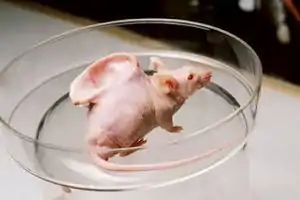Vacanti mouse
The Vacanti mouse was a laboratory mouse (circa 1996)[1] that had what looked like a human ear grown on its back. The "ear" was actually an ear-shaped cartilage structure grown by seeding cow cartilage cells into biodegradable ear-shaped mold and then implanted under the skin of the mouse, with an external ear-shaped splint to maintain the desired shape. Then the cartilage naturally grew by itself within the restricted shape and size. The splint was removed briefly to take the publicity pictures.[2]

The earmouse, as it became known, was created by Charles A. Vacanti in the Department of Anesthesiology at Massachusetts General Hospital and Harvard Medical School, Massachusetts General Hospital at Massachusetts Institute of Technology, Joseph P. Vacanti in the Department of Surgery at Children's Hospital. Vacanti later moved to the Department of Anesthesiology at the University of Massachusetts Medical School. The results were based on the works of many others who seeded cells onto scaffolds to regenerate organs. The first work with cartilage regeneration was published in 1991 in Plastic and Reconstructive Surgery. The mouse used is called a nude mouse, a commonly used strain of immunocompromised mouse, preventing a transplant rejection.
The photo of the mouse was passed around the internet, mainly via email, sometimes with little to no text accompanying it leading many people to speculate whether the photo was real. In the late 1990s, the picture prompted a wave of protests against genetic engineering—although in this specific experiment no genetic manipulation was performed.
References
- "Mouse with human ear". ABC Science. Retrieved 22 October 2019.
- Cao, Y.; Vacanti, J. P.; Paige, K. T.; Upton, J.; Vacanti, C. A. (1997). "Transplantation of chondrocytes utilizing a polymer-cell construct to produce tissue-engineered cartilage in the shape of a human ear". Plastic and Reconstructive Surgery. 100 (2): 297–302, discussion 303–4. doi:10.1097/00006534-199708000-00001. PMID 9252594.
External links
- Hugo, Kristin (September 16, 2017). "Remember the lab mouse with a human ear on its back? The scientist accused of "playing God" explains his work". Newsweek. Retrieved May 10, 2018.